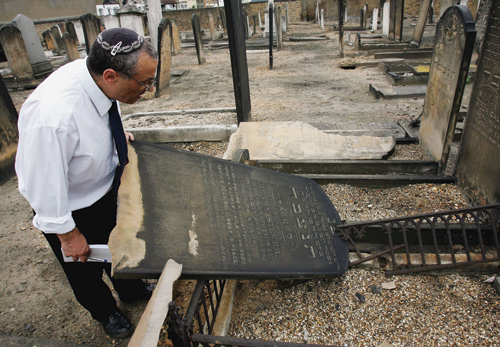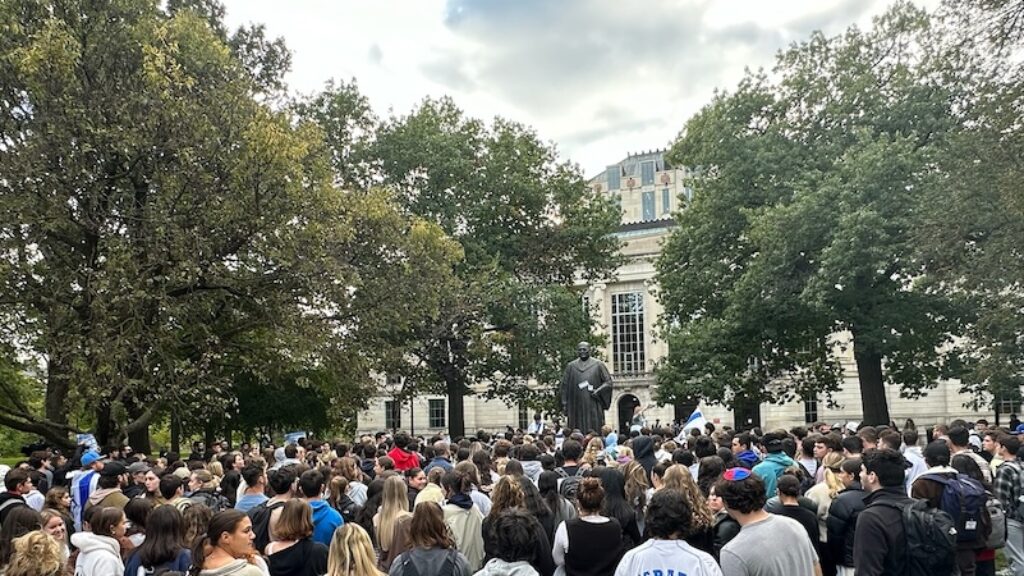The Devil You Know
Anti-Semitism had to go underground in many of its previous haunts after 1945, but it never disappeared, and in recent years has been on the upswing. It’s hard to tell how much of a menace it now constitutes because so much of it remains submerged and so much of it is disguised. From the vantage point of the United States, where anti-Semitism is but a weak force, the danger may not appear very great at all—especially now that Mahmoud Ahmadinejad has vanished from the international scene and his successor is tweeting Rosh Hashanah greetings to the Jewish people. It would be a mistake, however, to make light of the very substantial evidence that anti-Semitism is on the rise. We need to know who our enemies are and to think about how to deal with them.
Anti-Semitism manifests itself in words and deeds. Some of the words come unsolicited from the mouths and pens of Jew-haters, and others appear on questionnaires designed to elicit and sort the expression of sentiments people may otherwise have kept to themselves or shared only with their like-minded friends. Actions range from violent attacks on individuals to political scheming against the Jewish people. Analysts of contemporary anti-Semitism monitor and examine some or all of these things and situate them against the backdrop of history in an effort to assess the dimensions of the problems we now face.

Monika Schwarz-Friesel and Jehuda Reinharz’s new book on the language of “Judenfeinschaft” (hostility toward Jews) in the 21st century has a restricted focus, but it pursues a broad program. This unusual collaborative venture on the part of a German linguist and a modern Jewish historian (who was formerly the president of Brandeis University) is based mainly on the minute and meticulous study of around 14,000 emails, letters, and faxes sent to the Central Council of Jews in Germany and the Israeli embassy in Germany between 2002 and 2012. Schwarz-Friesel and Reinharz painstakingly analyze some very discomfiting reading material in search of an up-to-date and “comprehensive understanding of the culturally, socially, cognitively and emotionally charged phenomenon of hostility toward Jews” in the land where anti-Semitism not so long ago reached its apogee.
While some of the messages and missives under investigation were anonymously dispatched, most were not. The proportions varied, interestingly enough, in accordance with the political orientations of their authors. Signatures were missing from almost 43 percent of the correspondence emanating from right-wing extremists, a clear sign that their authors were aware that their views and opinions exceeded acceptable limits.
They do indeed go pretty far. I’ll reproduce just one of them, to give you the bad flavor: “Are you human beings at all? You often enough display the social habits of animals, rats or microbes!” One doesn’t need to be a distinguished social scientist or historian to catch the drift of this kind of talk. But it’s more the exception than the rule. Only four percent of the messages came from what Schwarz-Friesel and Reinharz characterize as the extreme right and, for that matter, only three percent from the extreme left. The majority—65 percent—came from the political middle, and it is with the analysis and interpretation of these emails and letters that our authors are primarily concerned.
How much anti-Semitism is reflected in the words of today’s ordinary Germans (to borrow an old coinage of Daniel Goldhagen, to whose newest book I will soon turn), or at least those who have strong enough feelings about matters Jewish to write to their country’s Jewish leaders or Israel’s representatives? Leaving aside the relatively small number of communications that were philo-Semitic or supportive of Israel, the answer is quite a lot. Most of it revolves around Israel. Indeed, “there is hardly a piece of writing in the whole corpus of texts that does not make mention of Israel”—usually in order to defame or delegitimize it. And in most of these texts, the anti-Israel arguments served to discredit all Jews. Not everything written against Israel ought to be stamped as anti-Semitism, Schwarz-Friesel and Reinharz hasten to acknowledge. They carefully draw the line between “criticism of Israel (as a legitimate expression of one’s opinion) and anti-Israelism (as a current variant of hostility toward Jews).”
An email like this one, our authors tell us, composed by a married couple in Bad Driburg in 2007 and sent to the Israeli embassy, is well within bounds:
This morning my wife and I heard on WDR 5 about the use of four million cluster bombs in the course of the Lebanese War on the part of your country during the past year. It is clear that still more people are going to be injured by them and for an unlimited period of time. We are astounded and alienated by the fact that Israel did not place the drop coordinates at the disposal of the minesweepers that were in operation there. We earnestly beseech you, Mr. Ambassador, to use your influence to have your government make the data public.
This complaint is fact-oriented, couched in rational language, temperate, and, for all its criticism, devoid of any explicit or implicit anti-Jewish or anti-Israel bias. But compare it to this one from two years later:
Are Jews really human beings? In the light of the crimes in Gaza and Lebanon, one can answer this question with a clear no. Perhaps we should once in a while apply the Jewish books to you. For one knows indeed what is written there—racist garbage, which makes you the filthiest racists. Forward march to the gas chamber! Heil Zion!
Here, the anti-Semitism lies on the surface, and there is no room for debate. But is that also the case with this one, from the same year?
To unload bombs with this kind of explosive power on a thickly settled city has absolutely nothing to do with legitimate defense. This is a conscious effort to cause civilian casualties. This State of Israel is a SCANDAL to the entire CIVILIZED world and for all those who still have the tiniest spark of decency. AND I AM NOT AN ANTISEMITE!
What vitiates this person’s emphatic disavowal of anti-Semitism, according to Schwarz-Friesel and Reinharz, is the way that he transforms Israel’s supposedly intentional misdeeds into evidence of its criminal abnormality, thereby engaging in a “derealization” of the country. This derealization, or prejudiced and twisted misperception of reality, is one of the many telltale signs of “antisemitic anti-Israelism” (which include the identification of Israel with apartheid South Africa, the demonization of Israel, the use of pejorative and dehumanizing language, the comparison of Israel’s government to the Nazi regime, and more). Often enough, the denial of anti-Semitism is itself an indication of its presence. “The utterance I am not an antisemite (in diverse variants) is by far the most commonly verbalized form of the strategy of avoidance in the texts sent to the Central Council of Jews and the Israeli embassy. More than 53% of the writers from the middle have recourse to it.”
The postwar taboo against anti-Semitism is still strong enough in Germany to require such precautions, even on the part of people who pile anti-Semitic clichés and arguments one on top of another in their denunciations of Israel. They want to avoid political incorrectness, even at the price of self-deception. What is, in the end, most disconcerting about Schwarz-Friesel and Reinharz’s analysis is their demonstration of the underlying kinship between the self-confessed anti-Semites on the extremes and the ostensible anti-anti-Semites of the middle. As they note in their book’s final sentences, despite all of their ideological, political, and social differences, most of the authors of the texts they have investigated speak the same anti-Semitic language and resort to largely similar rhetorical strategies.
Schwarz-Friesel and Reinharz embed their examination of recent expressions of anti-Semitism in Germany within a concise but wide-ranging survey of the history of European anti-Semitism and the anti-Jewish language it has generated over the centuries. They devote only a few pages, however, to a comparison of the German scene with other parts of the contemporary world. This is the concern of Resurgent Antisemitism: Global Perspectives, a collection of essays edited by Alvin H. Rosenfeld, a veteran student of the Holocaust and its literature. While this book’s scope is far broader than Schwarz-Friesel and Reinharz’s, its fundamental concerns are the same: the linkage between the old anti-Semitism and the new, the seepage of anti-Semitism into the European mainstream, and the intertwinement between anti-Semitism and anti-Israelism.

As Rosenfeld himself notes, every chapter in the book demonstrates that “we are once again witnessing a resurgence of hostility to Jews and, especially, to the Jewish state.” While the volume documents increases in anti-Semitic violence in various countries, it focuses primarily on the way in which old canards are being revived in new circumstances and with new twists. This is happening, clearly, all across Europe, and most menacingly, in the Middle East. What is especially troubling in the book’s accounts of the situation in individual European countries is the way in which anti-Semitism, or at least the tolerance of anti-Semitism, constitutes more than a fringe phenomenon.
In Great Britain, there are “boycott campaigns against Israeli Jews in which respectable academics distribute material by neo-Nazis” and “there are cover stories in the Left-Liberal press that feature antisemitic images worthy of fascist propaganda in the 1930s.” Spain’s most influential and respected newspaper published a cartoon that “exemplifies how critique of Israel embraces, without any inhibition or intellectual contradiction, the stereotypes that once were the exclusive components of classic antisemitism: Jews are rich, manipulative, mean-spirited, vindictive, greedy, and, in the end, inhuman and diabolic.” In Norway, “many attitudes that can properly be termed antisemitic have become publicly acceptable, as open antisemitic rhetoric has been smuggled back into mainstream political debates.” Similar things are taking place in France, Hungary, and other countries. Further aggravating the situation, the anti-Semitism of Muslim immigrants “has become one of the major factors in a number of Western European countries in the twenty-first century. It has added weight to antisemitism from the far Right, the Left, and mainstream society.”
It is in the Middle East itself, however, that anti-Semitism is most unbridled, and it is there that it protrudes most shockingly not only in the mainstream, but in leading governing circles. As Jamsheed K. Choksy, a professor of Iranian studies at Indiana University, notes in his essay on “Antisemitism’s Permutations in the Islamic Republic of Iran,” in the aftermath of his departure from office “Ahmadinejad is unlikely to be a long-term foe to Jewish communities in Iran, Israel, and elsewhere”—but that hardly matters. The real threat emanates from “the mollahs or Shi’ite clergymen” who are “central in the Iranian sociopolitical fabric.”
Unlike elected politicians, the ayatollahs and their supreme leader—who wields overall ultimate say over Iran’s government—are not transient. Many of them, especially politically active ayatollahs, routinely manipulate religious beliefs, historical traditions, and societal mores to propagate hatred for Jews and Judaism. More than any other group in Iranian society, those mollahs remain the main source of antisemitism in Iranian society. As a result, the rise and persistence of antisemitism in modern Iran is a very real danger to Jews, to the State of Israel, and to humanity’s ideals and values.
Determining the real magnitude of the threat posed to the Jews by the worldwide developments documented in the volume he edited is not a task that Alvin Rosenfeld sets for himself. “How aggressive this new antisemitism is likely to get and, ultimately, how destructive it will be if it proceeds unchecked,” he writes, “are open questions.” Nor does Rosenfeld seek to provide a unified and comprehensive explanation for the latest phase of antiSemitism, as Daniel Goldhagen attempts to do in The Devil That Never Dies: The Rise and Threat of Global Antisemitism.
Best known for his highly controversial 1996 volume Hitler’s Willing Executioners: Ordinary Germans and the Holocaust, Goldhagen has two additional books dealing with anti-Semitism and the Holocaust to his credit—and if one were to judge solely by what is included in the rather sparse footnotes in his The Devil That Never Dies, they are among the very few volumes on these subjects ever to appear. The prolific Israeli historian Robert Wistrich, for instance, who has written a great deal on the connection between anti-Semitism in Europe and the contemporary Islamic world (including an illuminating chapter in Resurgent Antisemitism), appears in Goldhagen’s footnotes not as the author of a 1,200-page tome entitled A Lethal Obsession: Anti-Semitism from Antiquity to the Global Jihad, but only in connection with a companion volume to a television series on anti-Semitism. Yet the fact that Goldhagen pays little heed to Wistrich or any of his other academic predecessors in the study of contemporary anti-Semitism is not likely to concern anyone other than professors and shouldn’t prevent us from considering what he himself has to say on this subject.
Goldhagen believes that we have in recent years entered the third era of anti-Semitism. The earlier Christian and racist eras have been succeeded (but not completely superseded) by one of global anti-Semitism. The “powerful subterranean prejudice” against the Jews that persisted in the West throughout the period of “the post-World War II illusion” is once more out in the open, where it has fed upon the anti-Semitism emanating from Muslim countries and spread virtually everywhere to constitute an unprecedentedly worldwide and insidiously pervasive threat.
Global anti-Semitism “is grounded in the same foundational antisemitic paradigm as medieval and modern antisemitism.” This paradigm, according to Goldhagen, “constructs Jews in their essence as being: different from non-Jews, noxious, malevolent, powerful (or potentially powerful), and dangerous.” The new anti-Semites see this essence as consisting of what Goldhagen himself deems “Jewness,” something that is not necessarily or even usually connected, as it was in the past, with the Jews’ “religious or other ideas” or their biology but is tied up with their ethnicity and their politics.
Thus the source of the Jews’ perniciousness today, whatever various other things different antisemites also consider it to be, is the Jews’ political identity, which means their allegiance to Jewness’ political goals, which is overwhelmingly defined by the repository of Jews’ politics and greatest political capacity as much as it is the repository of much of Jewish life: Israel.
Goldhagen surveys the enormous “litany of accusations against Israel [and] its Jews,” focusing primarily on the ways in which global anti-Semitism portrays Israelis “as the predators who crush the Palestinians” and who “may have even more territorial aspirations of domination and destruction.” He reviews, among other things, the ways in which
anti-Semites around the world continually refer to the demonology of the Protocols of the Elders of Zion in order to explain Israel’s successes. Having grasped the vast danger posed by Israel and the Jews, global anti-Semitism has arrived at the logical conclusion: “it is right, and it is necessary, to destroy Israel and, in some of this discourse’s central variants or streams, to destroy its Jews.”
Anti-Israel at its “core,” global anti-Semitism, according to Goldhagen, is not so much an outgrowth of hostility toward the Jewish state as it is a force that has seized upon its existence as an excuse for the venting of long-standing prejudices. It is not that Israel produces anti-Semitism, but “it is antisemitism that produces anti-Israelism.” But these two forces are, in Goldhagen’s eyes, virtually the same thing. Unlike Schwarz-Friesel and Reinharz, he offers no example of an anti-Israel position that could be considered to be free of anti-Semitism. In noting, however, that “hostility toward Israel, and the criticism of Israel, is not a result, certainly not merely or overwhelmingly a result, of Israel’s policies or actions or even of principled concern for the Palestinians,” he seems to recognize at least the slim possibility that such a thing might exist.
On one occasion, he goes a bit further. “Until roughly 1967,” he writes, “in the Islamic and Arab public discourses a distinction existed between Israel the country and its policies, and Jews as people or adherents of the Jewish religion.” It is only in more recent decades that political and religious leaders have obliterated this distinction and turned the Middle Eastern conflict into one between Muslims and Jews. This is not quite in tune, however, with Goldhagen’s overall argument, that “[e]ver since Israel’s founding in 1948 many Arab and Islamic countries were openly antisemitic and dedicated to Israel’s destruction.”
In any case, Goldhagen is certainly correct to claim that, “Arab and Islamic governments originated the new international antisemitic alliance and have been its driving spirit.” Still, for all the importance that he attributes to the machinations of these governments, he places greater emphasis on what has happened elsewhere:
Antisemitism’s resurgence in Europe has been crucial for global antisemitism’s character, spread, and efficacy. If the Europeans had continued to toe the post-Holocaust line that this prejudice must not see the light of day, not return to the public sphere, if the European taboo on its expression had not been eroded and eventually all but overthrown, then the Arab and Islamic discursive and institutional onslaught against Jews and Israel would have remained a parochial matter, important and threatening but parochial, maintaining itself as another developing world gripe against the developed world.
Goldhagen demonstrates in considerable detail that anti-Semitism is rampant not only in Europe, where relatively small numbers of Jews now reside, but in other parts of the world, where there are practically no Jews. “The percentage of antisemitic people in South Korea, as indicated by their stated unfavorable view of Jews, is forty-one. In Japan it is forty-four. In China it is an astonishing 55 percent—almost 750 million people!” Goldhagen acknowledges that this is a very low-intensity anti-Semitism, but finds it worrisome nonetheless. Even if their anti-Semitism remains mild, it will influence their “current and future encounters with Jews, whether in the flesh, in reaction to news about Jews or Israel, or in supporting or opposing policies that could affect Jews in or outside of Israel.”
If there is a bright spot on Goldhagen’s horizon, it is the United States. Compared to Europe, it is in many respects “a virtual paradise” for Jews. The “foundational antisemitic paradigm” still has some kind of a grip on tens of millions of Americans, but anti-Semitism has been in decline in this country for four decades:
If we additionally evaluate the comparative antisemitic figures in the context of American society where, compared to European countries and Europe as a whole, the American Jewish community is larger, enormously more visible, enormously more publicly identified as Jews, and enormously more openly self-assertive, then the American numbers look very good.
This is due in part to America’s heritage of tolerance for immigrants and minorities, in part to its legal separation between church and state, and in part to the way in which anti-Semitism “took a public and social nosedive” in the aftermath of World War II. The schools figure into the equation as well. “Education, which in the United States decidedly teaches people anti-prejudicial views and integrates them much more broadly into society’s public discourse, profoundly lessens antisemitism.” As a result, college graduates are only half as anti-Semitic as Americans with a high school education or less.
There is still cause for concern, however, in the United States, above all the rise and new respectability of “antisemitic expression in the guise of anti-Israel agitation.” And like secular institutions of learning everywhere, which are a “significant institutional pillar of global antisemitism,” American universities have become “enormously hostile to Israel and its Jews and, if only by seemingly natural extension, to Jews more generally.” This disparagement of American universities, only a few pages before the end of his book, is admittedly hard to reconcile with Goldhagen’s earlier emphasis on their salutary influence. One might perhaps write it off as an overheated response to the regnant trends in Middle East studies and to the rather questionable survey of American Jewish students to which he alludes. Or one might consider it prescient, in the light of such worrying signs as the just-published issue of the American Association of University Professors’ Journal of Academic Freedom, in which six out of seven invited contributors came out in favor of an academic boycott of Israel. In any event, the situation in the United States is, in the end, the least of Goldhagen’s worries.
What really frightens Goldhagen is what is going on in the rest of the world. And, indeed, the situation is not pretty, as all of the books examined here make clear. But are things really as dire as he thinks they are? Is eliminationist (another of his older coinages) discourse directed against the Jews going to produce, as he evidently fears, eliminationist policy? I cannot pretend to know. But if we conclude that he is right—what are we supposed to do about it?
A hundred years ago, those who sounded the alarm about anti-Semitism usually proffered solutions—either ameliorative or, we might say, escapist. They sought to combat anti-Semitism through legal action and education, or by dodging it, by migrating to Zion. In an age of anti-Semitic anti-Israelism, the latter solution is no longer available. Can we still employ the former? Goldhagen himself offers little reason to hope that it will prove efficacious in uprooting or weakening the “foundational antisemitic paradigm” that remains “deeply and broadly entrenched in European culture” and has become thoroughly pervasive in the Muslim world. He concludes his book with a short exhortation. “People of good conscience unite: Combat the devil that never dies, he who is named antisemitism.” But he leaves us hoping, more than anything else, that the United States will continue to be the rock on which Israel, in the broadest sense of the term, can rely.
Suggested Reading

Wisdom and Wars
If it were fiction, Lawrence’s Seven Pillars of Wisdom would be the greatest English war novel.

18 Questions with Jeremy Dauber: The Purim Edition
Who ruled the Borscht Belt: Allan Sherman or Lenny Bruce? Jewish comedy expert Jeremy Dauber casts his vote in a humorous interview—just in time for Purim.

Welcome to the New Campus Normal: A Dispatch from Ohio State
"They found the graffiti in a stairwell. Protect Jewish Lives, only the words were crossed out by a red X." Yoshua G. B. Tolle reports on Jewish campus life amid rising antisemitism.
What a Friend We Have in Jesus
A new crop of books about Jesus, by Jews and for Jews.
Comments
You must log in to comment Log In